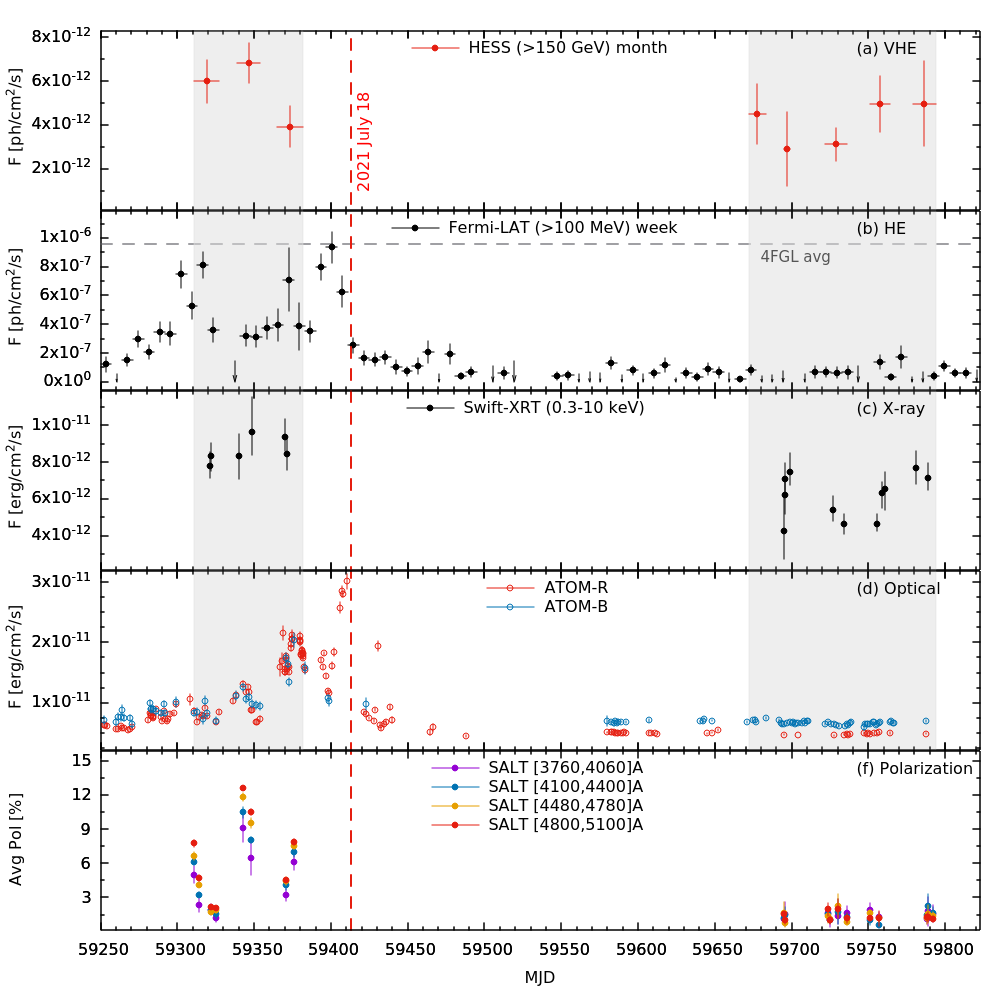September 2023
Blazars are the most abundant sources in the VHE sky and attract a lot of attention by changing their brightness on all time scales that have been probed so far. Variability implies that the flux can get very low, but it is rare to see a Blazar switching off for an extended period in time. It is even less expected that VHE gamma-ray emission would continue to be observed even when the signatures of blazar activity cease in other ranges of the electromagnetic spectrum. And yet just such a behavior has been observed in PKS 1510-089. In a study published this month, July 2023, the HESS collaboration reports about the identity crisis of this luminous blazar and the unexpected indifference of the VHE properties during this phase [1].
Blazars – as we have discussed many times in the Source of the Month series – are a special class of active galaxies. We speak of an active galaxy, if the supermassive black hole in the galactic center is surrounded by a disk of hot matter, which slowly falls into the black hole. Additionally, a jet may be formed, where magnetic fields and matter escape from the gravitational abyss along the rotational axis of the black hole. Such jets reach enormous speeds close to the speed of light and can be longer than the size of the galaxy. Inside of the jet, particles get accelerated to tremendous energies and emit radiation across the entire electromagnetic spectrum – from the radio through the optical to the gamma-ray regime. If the jet points directly towards Earth, its brightness is enhanced considerably (Note 1) allowing us to study jet physics in great detail. Such objects are referred to as blazars.
PKS 1510-089 is a so-called flat spectrum radio quasar. This implies that – in addition to being a blazar with the aforementioned ingredients – it also contains clouds of matter which circle the disk and the jet. These clouds form the “broad-line region” (BLR) and they are bright sources of optical radiation. From the point of view of a gamma-ray astronomer, the optical BLR radiation serves two purposes. On the one hand, the relativistic particles in the jet will use them to produce gamma rays through so-called inverse-Compton scattering. On the other hand, the BLR radiation can efficiently absorb the very-high-energy (VHE) gamma rays (Note 2) emitted by the jet. As the BLR extends only out to a certain distance from the black hole (which depends on the luminosity of the central region), one can use the absorption effect to place a constraint on the location of the gamma-ray emission region in the jet [2]. In other words, detection of VHE gamma rays from PKS 1510-089 implies that the VHE gamma-ray emission region must be located further away from the black hole than distance were radiation from the BLR clouds would absorb VHE radiation (SoM 06/2012).
As we discussed e.g. in SoM 01/2020, PKS 1510-089 reveals different faces. Discovered at VHE gamma rays back in 2009 [2] during a flare, it was seen during several multiwavelength flaring episodes (e.g. [3], [4]). During periods of reduced activity with flares at lower level , apparently continuous VHE gamma-ray emission was recorded by our colleagues from the MAGIC collaboration [4]. More unusual was the VHE gamma-ray flare observed with almost no counterparts in other bands (SoM 01/2020, SoM 02/2021). In this particular source a study on longer time scales did not confirm the expected correlation between the VHE gamma-ray band and other energy bands, including the HE gamma-ray band [5]. The latter is quite surprising, as one would normally expect that the HE and VHE gamma-ray bands are produced by the same process [6]. Indeed, PKS 1510-089 has always been an odd character.

And yet, in July 2021 it must have suffered a nervous breakdown. As one can see in Fig. 1, up until that time – marked by the dashed red line – the behavior was perfectly normal with variability in the HE gamma-ray and optical bands. Additionally, one sees in panel (e) the variability in the degree of optical polarization (Note 3), which is fluctuating between a few and about 15% – just as one expects from a blazar. However, after July 2021 all that variability ends. The HE gamma-ray and optical bands remain steady at a low flux level. The polarization is basically gone. Yet on the other hand, there is hardly any change in the VHE gamma-ray and X-ray band. This strange behavior can also be seen in the multiwavelength spectra shown in Fig. 2. The optical spectrum (~10^15 Hz) drops in flux. Likewise, the HE gamma-ray spectrum (~10^22 Hz) drops in flux at the lower energies, but changes much less at higher frequencies, where it connects to the VHE gamma-ray domain (~10^25 Hz). These changes occurred at the same time as the flux drop. The VHE gamma-ray spectrum does not change much; same as the X-ray spectrum (~10^17 Hz).

Fig. 2: Averaged spectra (energy flux as a function of frequency) of 2021 (red) and 2022 (blue). Archival data is shown in gray.
What does that all mean? What happened to PKS 1510-089?
We tried to answer that by performing a modeling of the spectra using a leptonic one-zone model. In that scenario a single emission region is used to explain both states. We vary the electron distribution, which then produces the observed radiation. The result is shown in Fig. 3 (left). In principle, reasonable fits for the periods before and after the change have been achieved. However, the required changes to the electron distribution must have happened during a very brief period in time. The change was so rapid (comparable to the crossing time) that it would imply an instantaneous change in the electron population. This — along with other constraints (such as location of the emission region within the jet) suggests this to be a rather improbable scenario.

Instead, we wondered if the model for 2022 could simply be a persistent zone located far away from the black hole, and which has also been present in the past. With an additional zone close to the black hole, one could explain the 2021 data in a two-zone scenario (Fig. 3, right). This near zone suddenly disappeared in July 2021 leaving the far zone on its own to represent PKS 1510-089. This interpretation has many advantages. First, no inexplicable and sudden changes to a single zone is needed. Second, the two-zone model would explain the persistent VHE gamma-ray emission [4], as the gamma rays from the far zone would not be susceptible to absorption in the thermal photon fields. Third, it would elucidate the aforementioned non-observations of correlated activity between the VHE gamma-rays and the HE gamma-ray band – as these spectral domains were produced in different emission regions.
And what made PKS 1510-089 lose its mind? That is, what made the near-zone disappear? As of now, we can only speculate. One possibility is that the inner part of the jet suddenly became less efficient in producing relativistic particles, which are required to produce the observable radiation. Another possibility could be that the inner jet has slightly moved away from the line-of-sight. Sideways motions of jets have been proposed for other sources, and a small change in angle can have a huge effect on the observable radiation (Note 1). Additional observations – especially in the radio domain, where the jet can be resolved on parsec scales – may provide the answer to this fascinating riddle.
Notes
(Note 1) The brightness enhancement is a consequence of Einstein’s theory of relativity, which dictates that radiation emitted by a source moving close to the speed of light is emitted predominantly in the forward direction.
(Note 2) “Very high energy” gamma rays implies an energy above 100 GeV, while “high energy” gamma rays exhibit energies above 100 MeV. For comparison, the optical domain is on the order of 2 eV.
(Note 3) As light may be described as electromagnetic wave, any wave-train will be polarized. This can be measured with a polarization filter providing the preferred orientation (polarisation angle) and the degree of polarization. Thermal radiation – such as star light or emission from the accretion disk and the BLR – is unpolarized, while synchrotron emission – from electrons in a jet for example – can be polarized depending on the ordering of the magnetic field. More specifically, a high degree of polarization implies high ordering, while low degree of polarization implies low ordering or a potential contribution from thermal sources diluting the polarized synchrotron emission. Measuring the degree of polarization of a jet thus provides information on the magnetic field ordering.
References
[1] H.E.S.S. collaboration, F. Aharonian et al.:The vanishing of the primary emission region in PKS 1510-089 , ApJ Lett., in press, (2023) and arxiv 2307.01692
[2] H.E.S.S. collaboration, F. Aharonian et al.:Astron. Astrophys. 554, A107 (2013)
[3] H.E.S.S. Collaboration: H. Abdalla et al.: Astron. Astrophys. 648, A23 (2021)
[4] MAGIC Collaboration, Acciari et al.: Astronomy & Astrophysics, 619, A159 (2018)
[5] Zacharias, M., Dominis Prester, D., Jankowsky, F., et al., Galaxies, 7, 41, (2019)
[6] Barnacka, A., Moderski, R., Behera, B., Brun, P., Wagner, S.: Astron. Astrophys. 567, A113 (2014)


